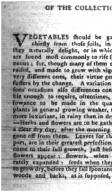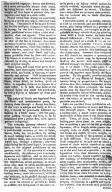[ Of the Collection and Curation of Simples ] Dr. Lewis
Date: 1791/08/05
Source:
Nova Scotia Magazine
Institution: Nova Scotia Archives
| Source Origin: Nova Scotia Newspapers on Microfilm
| Reference: Microfilm Reels 8062, 8063
Instructions for when to gather a variety of plants to be used in the making of medicinal simples, how to best preserve them, and then how to make simple. The instructions also turn to foreign resins, earths, and salts. nn.494_96. Microfilm Reel 8063.
OF THE COLLECTION AND CURATION OF SIMPLES
[By Dr. Lewis.]
VEGETABLES should be gathered
chiefly from those soils, in which
they naturally delight, or in which they
are found most commonly to rise sponta-
neous; for, though many of them may be
raised, and made to grow with vigour, in
very different ones, their virtue generally
suffers by the change. A variation of sea-
sons occasions also differences considera-
ble enough to require, oftentimes, an al-
lowance to be made in quantity;
plants in general growing weaker, though
more luxuriant, in rainy than in dry ones.
--Herbs and flowers are to be gathered in
a clear dry day, after the morning dew is
gone off from them. Leaves for the most
part, are in their greatest perfection, when
come to their full growth, just before the
flowers appear: flowers, when mode-
rately expanded: seeds when they begin
to grow dry, before they fall spontaneously:
woods and barks, as is supposed, in the
__
winter: annual roots, before the stalks
begin to rise: biennial roots, in the au-
tumn of the first year, or in the following
spring: perennial roots, before they begin
to shoot. Though the perennial, as well
as biennial roots, have been commonly
directed to be dug up in autumn, when the
leaves wither; they are both, generally
found to be most vigorous when the return
of spring has renewed their vegetative
power. To most of these rules there are
some exceptions, which are specified under
the particular subject.
Of the vegetables which lose their vir-
tue in being dried, the greater number,
perhaps all, may be preserved for a consi-
derable length of time, by impeding the
exhalation of their native moisture; for so
long as they retain this, they seem to re-
tain also their medical activity. Thus
roots have their virtue preserved by being
buried in sand, which should be dry, that
they may not vegetate; leaves and flowers,
of a more corruptible nature than roots,
by being beaten with about thrice their
weight of fine sugar to prevent their cor-
ruption, and kept in a close vessel.
Plants which bear drying are commonly
hung in a warm airy place, defended from
the sun. The colours of herbs and flowers
are for the most part changed or destroyed,
in drying, by the sun’s beams; but that
their medicinal virtue suffers a like dimi-
nution, does not appear. Thus much is
certain, that a heat of culinary fire, equal
to that of the sun in summer, does them
no injury in either respect: And that both
flowers and leaves, when thus hastily dri-
ed by the fire, preserve the liveliness of
their colour, and their smell and taste,
more perfectly than by slow exsiccation.
The leaves of moderately juicy plants are
reduced, by drying, to about one fourth of
their original weight.
Some roots, and some other parts of ve-
getables, how thoroughly soever they have
been dried, are liable, in keeping, to grow
mouldy and carious. This inconvenience
might probably be obviated by dipping
them, when dried, in boiling spirit of
wine, or exposing them to its vapour in a
close vessel. It is said, that some of the
oriental spices are made less perishable,
by being dipt in a mixture of lime and
water.
The pulps of fruit are separated from
the seeds and membranous parts, by
forcing them through a strong hair sieve.
If the fruit is unripe and hard, or if it is
dry, it should be previously softened by
boiling in a little water; and the pulp,
after passing through the sieve, is to be
inspissated over a gentle fire, with care to
prevent its burning.
The concrete gummy-refinous juices
brought from abroad, which have usually
a considerable mixture of hits of stalks,
leaves, seeds, &c. are purified, by adding
so much boiling water, as will so far soften
or dissolve them, that they may be pressed,
whilst hot, through a strainer; and then
inspissating the strained liquid, in a gentle
heat, to the original consistence of the
gummy-resin. If the quantity of water is
considerable, the resinous part commonly
separates and subsides, and in this case is
to be kept by itself till towards the end of
the inspissation of the gummy, at which
time they may be easily united again to-
gether into an uniform mass. Some of
the gummy-resins, exposed to the heat of
boiling water, melt thin enough, without
any addition, to be pressed through a can-
vas strainer. In either process, the opera-
tor must be careful to prevent as much
as possible, the dissipation of the more vo-
____
latile parts; an injury which cannot be
wholly avoided, especially when the sub-
jects are dissolved by water. The finer
tears unpurified are in many cases prefera-
ble, for internal use, to those that have
been strained.
Pulverable bodies of an earthy texture;
or such as are brittle and not dissoluble in
water, after being reduced to a powder of
moderate fineness, are brought to an im-
palpable or very volatile state, by grinding
them with a little water on some hard
smooth instrument: The matter is com-
modiously dried on a chalk stone, or ra-
ther on a cake of plaister of Paris, which
equally absorbs the moisture, without ad-
hering to the powder like substances of
the chalky kind. Powders thus levigated
are still found to contain a quantity of
gross parts; which may be separated by
shaking the matter with water, till it is
diffused through the fluid, and then suffer-
ing it to settle: The grosser parts soon
subside; and the turbid liquor, being now
poured off, deposits more slowly the finer
powder. By this process, powders may be
obtained of any degree of fineness; the
tenuity being in proportion to the length
of time that they remain suspended in the
fluid. On the same principle, the bolar
earths may be separated from the gritty
matter naturally mixed with them, metal-
lic bodies from those of the earthy kind,
and the calces of metals from metallic
particles uncalcined.
Salts are purified from indissoluble ad-
mixtures, by solution in water an filtra-
tion through paper. Water dissolves, in
a boiling heat, a much larger quantity of
most kinds of salts than it can retain when
cold: Thus, of nitre, it dissolves when
boiling near three times its own weight,
but in coolling a part of the salt gradually
separates, till at length, when grown tho-
roughly cold, in frosty weather, it does
not retain one eighth its own weight, or
one twenty-fourth of the quantity of salt
at first dissolved. The neutral salts, or
those composed of an acid and an alkali;
several of those which consist of an acid
and an earthly or metallic body; and ma-
ny of the acid salts of vegetables; in this
separation from their solutions, concrete,
unless too hastily forced together by sud-
den cooling, or disturbed by agitation or
other causes, into transparent masses, of
regular figures peculiar to each particular
kind of salt, and thence called crystals--
There are two general methods of reco-
vering salts from their solutions in a cry-
stalline form; one adapted to some salts,
and the other to others. The one is, by
keeping the solution in a gentle and equa-
ble warmth, that the water may gradually
[page break]
exhale and leave the salt crystallized. The
other is, by boiling down the solution,
till, on dropping a little of it on a cold
glass plate, crystalline filaments appear;
then covering the vessel, and suffering it
to cool very slowly: Some of the difficult-
ly crystallizable salts are made to shoot
more freely, by adding, after sufficient
evaporation, a small proportion of rectified
spirit of wine, which weakens the dissol-
ving power of water on most kinds of sa-
___
line bodies.--As different salts require dif-
ferent quantities of water to keep them
suspended; when two or more are dissol-
ved together, they begin to concrete at dif-
ferent periods of the evaporation, that
which requires most water for its dissolu-
tion, shooting first, and leaving the more
soluble dissolved: On this foundation,
salts are purified, by crystallization, from
admixtures of one another.
Download: Transcription | Images


